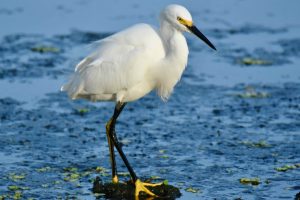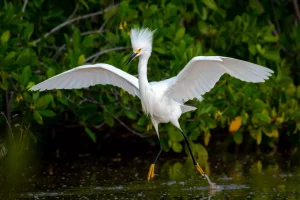Against the dark waters and green marsh grasses of the Chesapeake Bay, you’ll often see nature’s most elegant ballerinas put on a daily performance. Snowy egrets, draped in feathers as white as fresh snow, catch every ray of sunlight as they stalk the shallows on their most distinctive feature – bright yellow feet that look like they’ve been dipped in paint as bright as in a Vincent Van Gogh’s painting. Watch a snowy egret in flight and you’ll witness the definition of grace. Their pure white forms seem to float across the sky, long black legs trailing behind, their wings beating with a fluid rhythm that makes each movement appear effortless. Against a blue summer sky or the dark green of the shoreline forest, they draw every eye with their brilliant whiteness.

These delicate birds bring a touch of tropical grace to our Bay’s shorelines during the warmer months, arriving in spring from their southern wintering grounds. Standing about two feet tall, they’re noticeably smaller than their great egret and heron cousins. But what they lack in size they make up for in personality.
One of the most entertaining aspects of snowy egret behavior is their seemingly dainty appearance contrasted with their aggressive fishing techniques. Those yellow feet aren’t just for show – they’re actively used to shuffle and splash in shallow water, creating confusion among small prey. Their slim black bills dart with lightning precision at any small fish or crustacean curious enough to investigate the commotion Sometimes they’ll even spread their wings like umbrellas, creating shade that attracts fish seeking cover. This combination of grace and practical fishing skill makes them fascinating to watch.
During breeding season, these already beautiful birds transform even further into something truly spectacular. Delicate plumes, called aigrettes, grow from their back and neck, creating a gossamer waterfall of fine white feathers that drift in the slightest breeze. These were once their downfall, prized by the fashion industry for ladies’ hats, but today they serve their intended purpose – making their wearers irresistible to potential mates.

Along the Bay’s more sheltered shores, these elegant birds gather in mixed colonies to nest, often sharing island rookeries with other herons and egrets. Their stick nests, while not as massive as those of larger waders, are carefully constructed in trees or tall shrubs, usually over water. During nesting season, these colonies become raucous gathering places, with parents constantly coming and going, their breeding plumes catching the breeze like delicate white flags.
For visitors cruising the Bay’s waters, snowy egrets provide perfect photography opportunities. Their brilliant white plumage stands out dramatically against any background, and their hunting behaviors offer endless entertainment. Look for them in shallow coves and tidal creeks, especially where marsh grasses meet open water. They’re particularly active during falling tides, when small fish become concentrated in shallow pools.
As summer wanes, these beautiful birds begin their journey south, leaving our Bay until the following spring. Their departure marks the changing of seasons as surely as any calendar, but while they’re here, they bring a special magic to the Chesapeake’s shores. Their presence reminds us of the Bay’s connection to more tropical waters, and their annual return is a celebrated sign of spring.
So on your next Bay excursion, watch for these white jewels along the shoreline. Whether you spot one delicately picking its way through the shallows on those comedic yellow feet, or see a group in flight, brilliant white against the blue sky, you’re witnessing one of the Chesapeake’s most elegant seasonal visitors. In their graceful presence, we’re reminded of nature’s capacity for both beauty and resilience, as these once-threatened birds continue to adorn our waters with their stunning displays.
